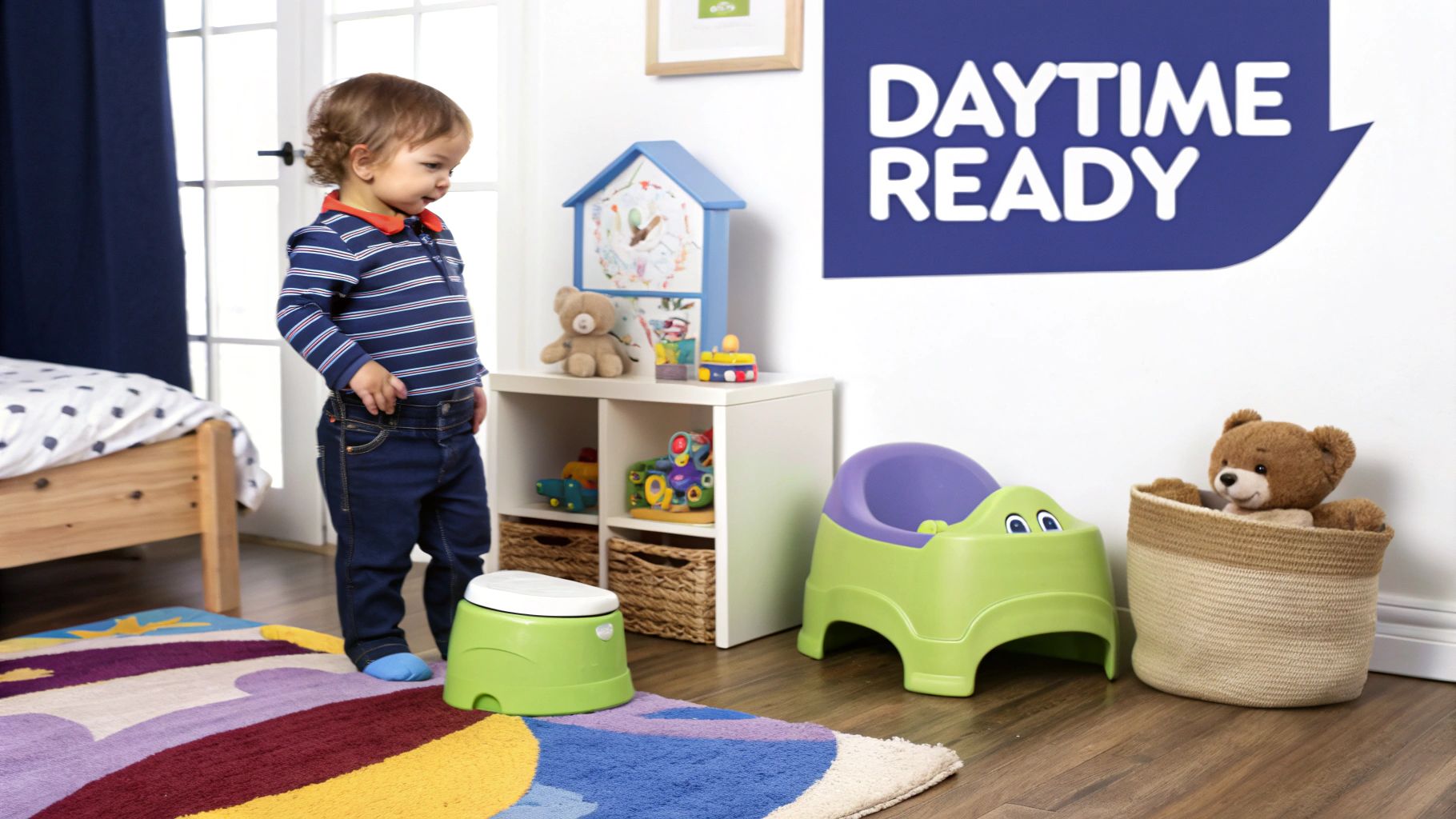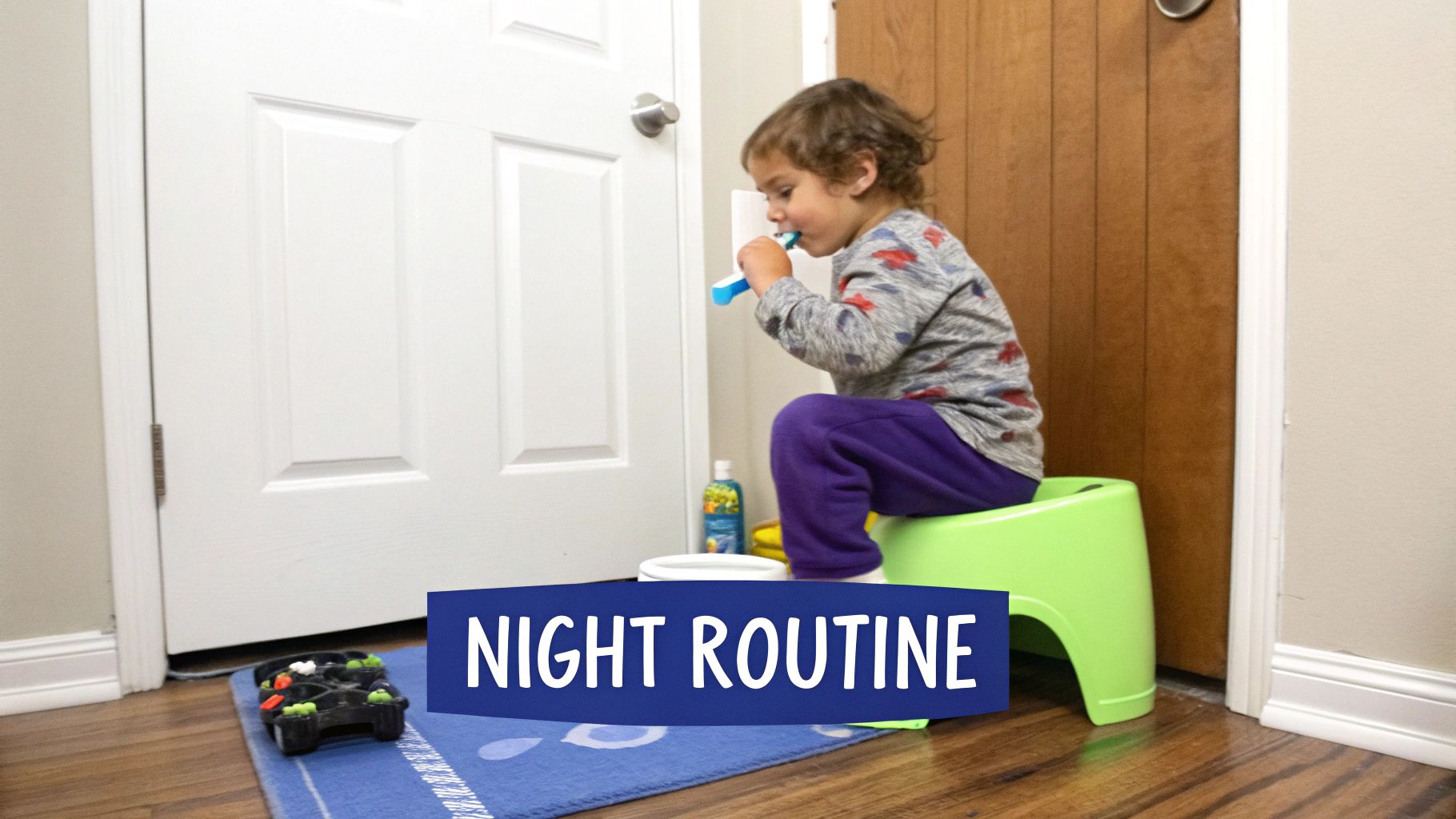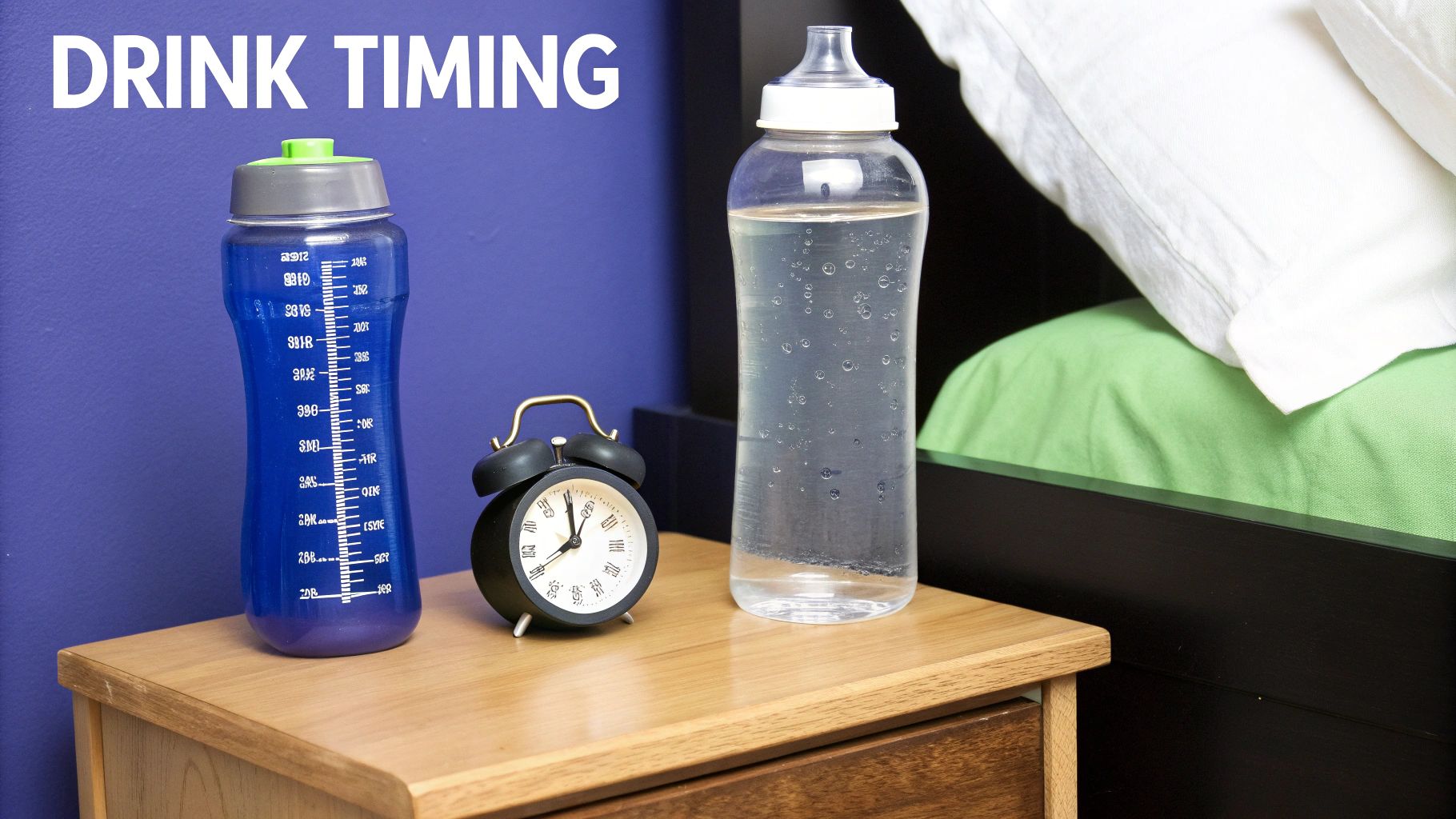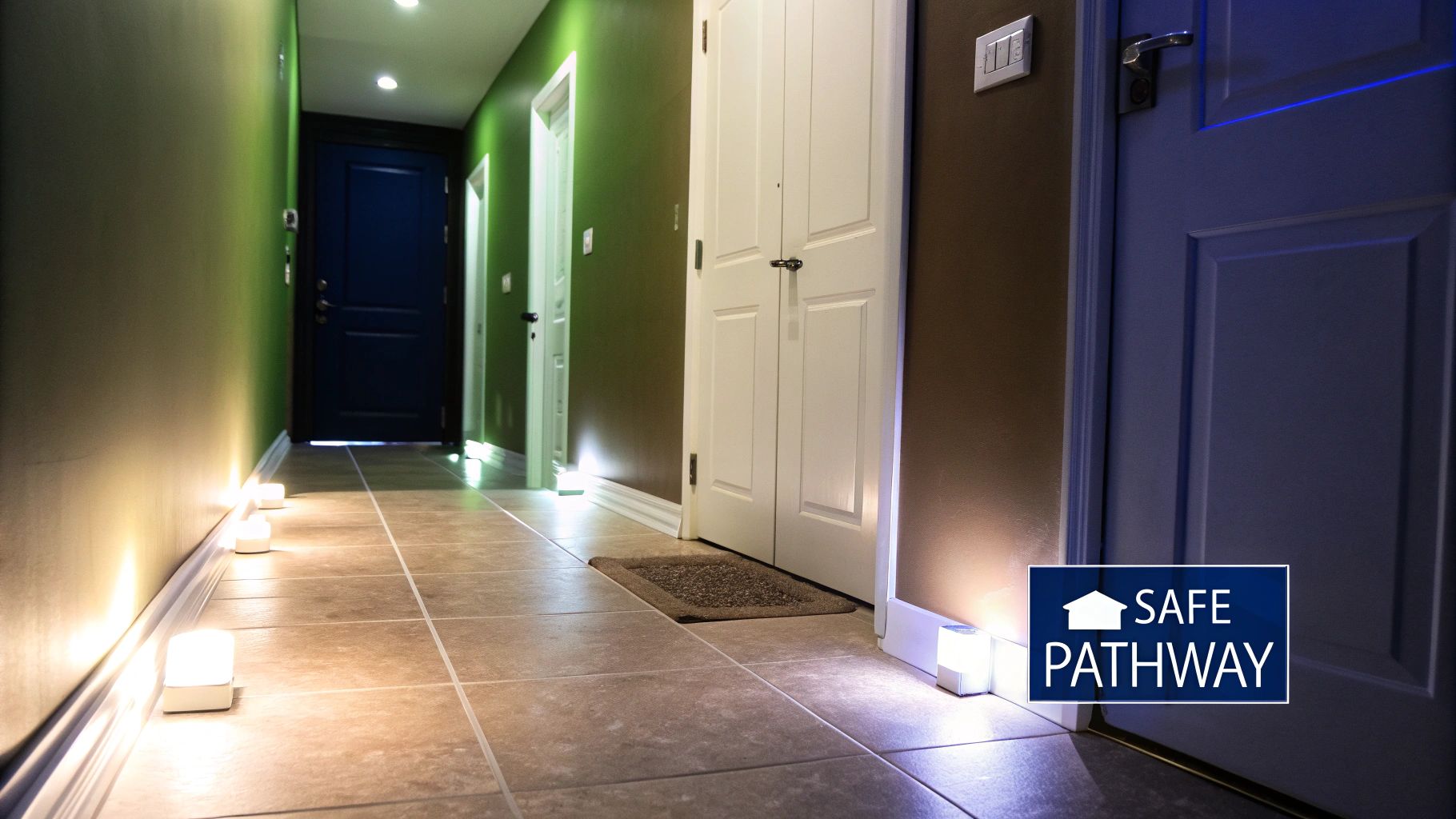Embarking on the Final Frontier: Mastering Nighttime Dryness
Welcome, parents, to one of the most anticipated and often challenging milestones in your child's development: mastering nighttime potty training. You have conquered daytime potty use, celebrated the small victories, and now you are looking toward the final frontier of diaper-free living. But as many caregivers quickly discover, staying dry at night is a completely different challenge.
This process is less about willpower and more about biology. It involves deep sleep cycles, bladder capacity, and the production of a specific hormone that slows urine production overnight. While this physiological process cannot be rushed, it can be supported. Many parents wonder if their child is ready, how to handle accidents, and what strategies actually work without causing frustration.
This guide is designed to move beyond generic advice and provide you with a comprehensive toolkit of specific, actionable night potty training tips. We will explore the "why" behind each strategy, from managing fluids and creating a supportive environment to understanding the critical role of developmental readiness. By the end of this article, you will have a clear plan to guide your family through this process, transforming it from a source of stress into a confident step toward your child's independence.
1. Wait Until Daytime Training is Fully Established
One of the most foundational night potty training tips is also one of the simplest: master daytime dryness first. Nighttime bladder control is a physiological milestone, not just a behavioral one. It requires the brain to recognize the sensation of a full bladder during deep sleep and then wake the body up in time to use the toilet. This mind-body connection develops significantly later than daytime control, which is why experts, including the American Academy of Pediatrics, strongly advise against rushing the process.

Starting too early can lead to frustration for both you and your child, potentially causing setbacks in their overall potty training journey. The goal is to set your child up for success, and patience is the key ingredient. By waiting for clear signs of readiness, you ensure their body is truly prepared for this next big step.
Why This Approach Works
Attempting nighttime training before the body is ready is like trying to teach a child to run before they can walk. Daytime training builds the fundamental skills: recognizing the urge to go, holding it, and independently using the toilet. Nighttime control relies on an involuntary hormone called vasopressin, which reduces urine production during sleep. This hormone production increases as a child matures, making nighttime dryness a matter of physical development. Pushing before their body is ready can lead to bedwetting, feelings of failure, and unnecessary stress.
Signs Your Child is Ready
Look for concrete evidence that daytime potty use is second nature. Don't just go by a few good days; you need to see consistent patterns over several weeks or even a few months. Key indicators include:
- Consistent Dry Naps: The child regularly wakes up dry from naps lasting two hours or more.
- Morning Dryness: You notice their diaper is dry upon waking at least 3-4 mornings per week. This is a strong sign that their body is beginning to manage urine production overnight.
- Extended Bladder Control: During the day, they can go 3-4 hours between bathroom trips without accidents.
- Child-Led Interest: They start asking to wear underwear to bed or express a desire to sleep without a diaper.
Waiting for these signals makes the transition smoother and more successful, reinforcing their confidence. For a more comprehensive overview of this developmental stage, you can explore this ultimate guide to potty training.
2. Establish a Consistent Bedtime Bathroom Routine
Consistency is a cornerstone of successful child development, and this holds especially true for night potty training. Establishing a predictable bedtime routine that heavily features bathroom visits can train both the body and mind for a dry night. The goal is to make emptying the bladder a non-negotiable, automatic part of winding down for sleep, significantly reducing the chances of a full bladder waking them (or not waking them) in the middle of the night.

This routine isn't just about a single trip to the toilet before bed. It involves creating multiple opportunities to go, ensuring the bladder is as empty as possible. By integrating potty trips into a calming sequence of events, you remove the pressure and make it a natural conclusion to the day, setting your child up for nighttime success.
Why This Approach Works
Children thrive on predictability, and a structured routine helps cue their bodies for sleep. By incorporating multiple potty breaks, you are essentially "double-voiding," a technique where you urinate a second time a few minutes after the first to ensure the bladder is completely empty. This simple practice can be one of the most effective night potty training tips because it physically prepares the child for the long stretch ahead without a bathroom break. A calm, consistent process also minimizes bedtime resistance, making the final potty visit less of a battle and more of a habit.
Building this habit requires a clear, repeatable sequence of events every single night. The key is to make it feel supportive, not stressful. Consider this effective structure:
- The First Visit: Make the first potty stop happen at the beginning of the bedtime routine, perhaps right before bath time or putting on pajamas.
- The Final "Just in Case" Visit: This is the most crucial step. After stories are read and cuddles are done, have a final, non-negotiable potty visit right before they get into bed. Frame it as "tucking the potty in for the night."
- Make it Accessible: Use a soft bathroom nightlight to make the space feel safe and less intimidating. A special potty seat or a sturdy step stool can make them feel more secure and independent.
- Keep it Positive: Avoid turning the routine into a power struggle. Use gentle reminders and positive reinforcement, like a sticker on a chart for completing all the bedtime steps, including the final potty visit.
3. Manage Fluid Intake Strategically
A crucial yet often misunderstood part of the potty training process is managing your child's fluid intake. This isn't about restricting water; it's about timing. Strategic fluid management involves ensuring your child is fully hydrated during the day and then gradually tapering off liquids in the hours leading up to bedtime. This simple adjustment gives their developing bladder a better chance of staying empty overnight, setting them up for a dry and successful morning.

The goal is to prevent the bladder from becoming overly full during deep sleep, which is when the body's natural "wake-up" signals are weakest. By front-loading hydration earlier in the day, you meet their physical needs without overwhelming their system at night. This practical approach is one of the most effective night potty training tips for preventing accidents and building confidence.
Why This Approach Works
When a child consumes large amounts of liquid right before bed, their kidneys continue to produce urine at a high rate as they fall asleep. Since their body hasn't fully developed the hormonal control (vasopressin) to slow urine production overnight, their bladder fills up quickly. By limiting fluids 2-3 hours before bedtime, you give them a chance to empty their bladder completely before sleeping, significantly reducing the likelihood of bedwetting. This method works with their natural physiology rather than against it, making dryness more attainable.
How to Implement This Strategy
Successfully managing fluids requires a conscious plan throughout the day, not just at night. Focus on hydration from morning until mid-afternoon, then begin to taper.
- Front-Load Fluids: Encourage plenty of water and milk from breakfast through the early afternoon. Using a fun, marked water bottle can help track their intake and make it a game.
- Timing is Everything: Aim to stop offering large drinks about 2-3 hours before their scheduled bedtime. For example, if bedtime is 8 PM, their last big drink should be with dinner around 5:30 or 6 PM.
- Avoid Bladder Irritants: Some drinks can irritate the bladder and increase the urge to urinate. In the late afternoon and evening, steer clear of citrus juices, carbonated drinks, and anything with caffeine like chocolate milk.
- Handle Bedtime Thirst: If your child complains of being thirsty right before bed, offer a few small sips of water or even ice chips. This can quench their thirst without filling their bladder. Keep a small, designated cup by their bed for this purpose.
4. Use Waterproof Protection Without Relying on Diapers
Once your child is ready to move beyond diapers, the next step is creating a sleep environment that supports their training without causing you major laundry headaches. This involves strategically using waterproof bedding to protect the mattress. This approach allows your child to feel the sensation of wetness when an accident happens, a crucial feedback loop for learning, while preventing damage to furniture and minimizing cleanup stress.

The goal is to embrace the "big kid" status of wearing underwear to bed, which is a powerful psychological motivator. By pairing underwear with a protected bed, you communicate trust in your child's growing abilities while practically preparing for the inevitable accidents. This balance is one of the most effective night potty training tips for a smooth transition.
Why This Approach Works
Moving directly from diapers or pull-ups to underwear at night reinforces the learning process. Unlike highly absorbent disposables that wick away moisture instantly, regular underwear allows the child to connect the feeling of being wet with the act of urination. A waterproof mattress protector, however, acts as a safety net. This setup prevents accidents from becoming a source of major frustration for parents, making it easier to remain calm and supportive during middle-of-the-night changes. It keeps the focus on learning, not on laundry and cleanup.
How to Set Up a Protected Bed
Creating a "no-stress" bed setup is simple and can save you valuable time and energy. The key is to layer protections for quick changes.
- Layering Method: On the bare mattress, place a waterproof mattress cover. Over that, put a fitted sheet. On top of the sheet, place a large, washable waterproof pad. Finally, add another fitted sheet. When an accident happens, you can simply remove the top sheet and pad, revealing a clean, dry layer underneath.
- Training Pants as a Bridge: Absorbent, reusable training pants can be a good intermediate step. They feel more like underwear but offer a bit more protection than standard cotton briefs, giving you an extra line of defense when paired with a waterproof mattress cover.
- Keep Supplies Nearby: Have a complete set of clean pajamas, a fresh waterproof pad, and sheets folded and ready near the bed. This makes nighttime changes fast and efficient, allowing everyone to get back to sleep quickly.
- Involve Your Child: Let them help pick out special "big kid" underwear for bedtime. This builds excitement and gives them a sense of ownership over the process, turning a challenge into a milestone they want to achieve.
5. Implement Strategic Night Wakings
A proactive approach to nighttime dryness involves strategically waking your child to use the toilet. This method, sometimes called "lifting," isn't about simply preventing accidents; it's an active training technique. By consistently waking your child before their bladder gets too full, you are conditioning their brain to recognize the sensation of needing to pee even during sleep. Over time, this helps their body learn to either wake itself up or hold urine until morning.
This is one of the more hands-on night potty training tips, requiring commitment from the parents. The goal is to gently guide the child's physiological responses, making the connection between a full bladder and waking up. When done correctly, it can significantly shorten the time it takes to achieve consistent nighttime dryness by building a new sleep-wake habit.
Why This Approach Works
This technique directly addresses the developmental gap in night training. A young child's brain may not yet respond to the signals sent by a full bladder during deep sleep. A scheduled waking interrupts this process and forces the association. You are essentially doing the brain's job for it temporarily, teaching it the proper response. This repeated practice helps forge the necessary neural pathways, so the child eventually begins to wake independently, which is the ultimate goal of night potty training.
How to Implement Strategic Wakings
Success with this method hinges on careful timing and a low-key approach. You want to make the bathroom trip as boring and sleepy as possible to avoid fully waking the child.
- Initial Timing: For the first few nights, wake your child about two to three hours after they fall asleep, typically right before you go to bed yourself (e.g., between 10 PM and 11 PM). You can also set a second alarm for 2-3 AM if they often have accidents in the early morning.
- Keep it Calm: Use only a dim nightlight. Speak in a quiet, calm voice, saying something simple like, "It's time for a quick potty trip." Avoid turning on bright lights or engaging in conversation.
- Encourage Independence: Gently guide your child to the bathroom. While carrying them is tempting, having them walk (even if sleepy and supported) helps them register the action more consciously.
- Gradual Reduction: Once they are consistently dry with the scheduled wakings, start to phase them out. You can push the first waking time later by 15-30 minutes each night or eliminate the second waking first, gradually training their bladder to hold more for longer periods.
6. Create an Accessible Nighttime Bathroom Environment
A significant barrier to nighttime potty training success isn't just a child's ability to wake up, but their willingness to navigate a dark and potentially intimidating house. Creating a clear, safe, and welcoming path to the toilet removes physical and psychological obstacles that might make staying in bed seem like the easier option. This is one of the most practical night potty training tips because it empowers your child to act on their body's signals independently.
Making the environment accessible turns a potentially scary midnight journey into a simple, manageable task. By reducing fear and uncertainty, you give your child the confidence to get up on their own, a crucial step towards consistent nighttime dryness. The goal is to make the trip from bed to toilet so easy they can practically do it in their sleep.
Why This Approach Works
Imagine waking up in the middle of the night, disoriented and needing the bathroom. For a small child, a dark hallway can feel vast and full of imaginary monsters. This fear can easily override the physical urge to pee, leading them to simply go back to sleep and have an accident. An accessible environment directly combats this fear. By lighting the way and ensuring the path is clear, you remove the mental hurdles, allowing the child to focus solely on the task of getting to the toilet in time. This simple environmental change can dramatically increase their success rate and build lasting confidence.
How to Set Up the Environment
A well-planned environment is key. Your setup should be simple, intuitive, and focused on safety and ease of use. Consider these practical and effective adjustments:
- Clear the Path: Remove any toys, laundry baskets, or other tripping hazards from the floor between your child's bed and the bathroom. A clear path is a safe path.
- Light the Way: Place motion-activated or plug-in night lights along the route. Opt for red or amber-toned lights, as they are less likely to disrupt sleep hormones like melatonin compared to blue or white lights.
- Provide an In-Room Option: For younger children or those just starting, placing a small potty chair right next to their bed is often the most effective solution. This minimizes the journey and makes it incredibly easy for them to use the toilet immediately upon waking.
- Make the Toilet Visible: A glow-in-the-dark toilet seat or a small motion-activated light placed inside the toilet bowl can help your child aim and use the toilet without fumbling for a bright overhead light switch.
Ensuring the entire route is safe is part of this process. For a detailed guide on identifying and removing potential hazards, you can review this complete baby-proofing checklist.
7. Maintain Positive Reinforcement and Patience
Of all the night potty training tips, maintaining a patient and positive attitude is arguably the most crucial for long-term success. Nighttime bladder control is a developmental process, not a race. Your child's body will get there on its own timeline, and your role is to provide encouragement and support, not pressure. Accidents are an inevitable part of this journey, and how you respond to them can either build your child's confidence or create anxiety that hinders progress.
Starting this phase with realistic expectations prevents frustration for everyone involved. The goal is to create a low-stress environment where your child feels safe to learn and even to fail. A positive framework celebrates effort over perfection, teaching your child resilience and fostering a healthy attitude toward learning new skills. This patient approach respects their individual developmental pace and strengthens your parent-child bond.
Why This Approach Works
Punishment or shaming a child for bedwetting is counterproductive. Since nighttime wetting is often involuntary, negative reactions can cause stress and anxiety, which can actually increase the frequency of accidents. Conversely, positive reinforcement creates a motivating and supportive atmosphere. When children feel praised for their efforts, like waking up to try or having a partially dry night, they are more likely to stay engaged and feel good about the process. This transforms a potentially stressful milestone into a collaborative and positive experience, reinforcing that you are a team.
How to Implement Positive Reinforcement
Focus on celebrating small victories and maintaining a consistent, encouraging routine. The key is to acknowledge the effort, not just the outcome.
- Create a Success Chart: Use a simple sticker chart where your child earns a sticker for every dry night. After earning a certain number of stickers, they can get a small reward, like a special one-on-one breakfast with a parent or choosing the family movie.
- Praise the Attempt: If your child wakes you up to go to the bathroom, even if they had a small accident first, praise them enthusiastically. Say something like, “Great job listening to your body and waking up! That’s a huge step!”
- Use Encouraging Language: Frame the process positively. Instead of saying, “Don’t wet the bed tonight,” try, “Your body is learning to stay dry all night long, and I’m so proud of you for trying.”
- Involve Them in Cleanup, Without Shame: If an accident happens, involve your child in the cleanup process in a matter-of-fact way. Have them help put the wet sheets in the laundry basket. This teaches responsibility without associating the act with punishment or disappointment.
7 Key Night Potty Training Tips Comparison
| Approach | Implementation Complexity 🔄 | Resource Requirements ⚡ | Expected Outcomes 📊 | Ideal Use Cases 💡 | Key Advantages ⭐ |
|---|---|---|---|---|---|
| Wait Until Daytime Training is Fully Established | Medium (requires tracking dryness) | Moderate (time and observation) | Builds solid foundation for night training | Children with consistent daytime dryness | Reduces accidents, builds on success |
| Establish a Consistent Bedtime Bathroom Routine | Medium-High (structured routine) | High (parent involvement, time) | Maximizes bladder emptying, reinforces habits | Ages 3-5, children who need routine and structure | Predictable routine, reinforces habits |
| Manage Fluid Intake Strategically | Low (timing fluids) | Low (monitoring intake) | Reduces nighttime urine volume | Children prone to heavy nighttime urine production | Easy to implement, teaches cause-effect |
| Use Waterproof Protection Without Relying on Diapers | Low-Medium (product setup) | Moderate (purchase of protective items) | Protects mattress, encourages underwear use | Children transitioning from diapers | Protects bedding, feels more grown-up |
| Implement Strategic Night Wakings | High (requires waking child nightly) | High (parent commitment, disruption) | Prevents accidents, trains bladder capacity | Children who regularly wet bed and respond to wakings | Active accident prevention, confidence |
| Create an Accessible Nighttime Bathroom Environment | Low-Medium (setup environment) | Moderate (lighting, equipment) | Encourages independent nighttime toileting | Children afraid of dark or with obstacle-prone paths | Reduces barriers, promotes independence |
| Maintain Positive Reinforcement and Patience | Medium (consistent encouragement) | Low (time, positivity) | Supports child emotionally, long-term success | All children, especially those needing emotional support | Reduces stress, boosts self-esteem |
Your Path to Dry Nights: Key Takeaways for the Journey Ahead
Successfully navigating the world of night potty training is a marathon, not a sprint. It is a unique developmental journey that combines biological readiness with consistent routines, a supportive environment, and an abundance of patience. As you embark on this next chapter with your child, remember that the most effective approach is a holistic one, built upon the foundation of actionable strategies and unwavering encouragement.
Synthesizing Your Night Potty Training Plan
Recalling the core concepts we've explored, your path forward becomes much clearer. The journey begins not at night, but during the day. Ensuring your child has fully mastered daytime potty use is the critical first step, signaling that their body is beginning to develop the necessary bladder control. From there, your focus shifts to creating a predictable and supportive evening structure.
Key pillars for your strategy include:
- Routine and Rhythm: A consistent bedtime bathroom routine becomes a non-negotiable end to the day. Similarly, managing fluid intake strategically in the hours before bed significantly increases the chances of a dry night without depriving your child of necessary hydration.
- Empowerment and Environment: Setting up the bedroom and hallway for success is paramount. This means using waterproof mattress protectors to minimize stress over accidents and ensuring the path to the potty is well-lit and obstacle-free. This empowers your child to act independently if they wake up needing to go.
- Patience and Positivity: Your reaction to accidents shapes your child's entire experience. Responding with calm reassurance and celebrating every small victory, like a dry morning or a self-initiated trip to the potty, reinforces confidence. Avoid pressure and remember that setbacks are a normal part of the learning curve.
Actionable Next Steps for Parents
Moving from knowledge to action is your next task. Start small. Tonight, focus on perfecting the bedtime routine and having a calm conversation with your child about the goal of staying dry. Tomorrow, assess their bedroom from their perspective. Is the nightlight bright enough? Can they easily get out of bed and open the door?
One of the most valuable night potty training tips is to remain a patient coach, not a demanding director. Trust in your child’s unique timeline and your own parental intuition. You have the knowledge and the tools to guide them toward this important milestone. Stay consistent, stay positive, and celebrate the progress, one dry night at a time.
As you navigate the many stages of parenthood, having the right gear can make all the difference. For versatile solutions that grow with your family, from childproofing essentials to multi-function diaper bags that keep you organized on the go, explore the thoughtfully designed products at Benny Bradley's. Simplify your journey so you can focus on what truly matters: creating a supportive and loving environment for every milestone.
